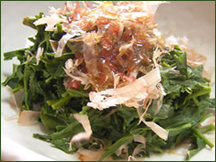This warm water steeping technique is not very well known even in Japan except among tea connoisseurs. We like to compare it to an espresso in the coffee world…a sencha espresso.
Before you begin, you’ll need to have some pretty high quality sencha. Spring harvested, shaded tea leaves (Kabusecha). You can also use this method with gyokuro although for gyokuro, you generally want to use an even lower temperature, at least for the first steep.
Flavor: The tea produced by this brewing technique is very sweet, almost syrupy, because the lower temperature of the water brings out the theanine amino acids (which give you a strong umami or savory flavor) and not the catechins (which cause astringency). However, unlike the gyokuro steeping technique (even more syrupy!), we can also enjoy the astringency of the tea in a perfect balance.
INSTRUCTIONS
Serves: One – two people. Serve in small guinomi cups (like a shot glass) and enjoy slowly.
Water amount: 80 cc (or 80 ml, 2.7 fluid ounces, 1/3 cup)
Water temperature: 50-70˚C / 122-158˚F (hotter temperature for more astringency)
Tea leaf amount: 3-5 grams (about one teaspoon)
Steep time: 2 minutes
- Use approximately 80 cc (or 80 ml, 2.7 fluid ounces, 1/3 cup) of boiling water.
- Pour into your cold teapot. As the water warms the teapot, its temperature drops about 10 degrees.
- When the teapot feels warm, pour into your cups.
- Place your tea leaves (5 grams or about a palm’s worth) into the pot.
- After a 2-3 minutes, the hot water in the cup should have cooled to about 70C/160F degrees (warm but not hot to touch). Pour it back into your teapot to steep the leaves. (You might want to warm up two cups to get the temperature down to 70˚C faster.)
- Steep for 2 minutes and pour back into your cup for some tea espresso!
2nd – 4th Steeps
After this first steep, you can steep 2 – 4 more times at a hotter temperature, generally 80-100˚C (176-212˚F) degrees. The second steep can be quick, 10 – 20 seconds. The third and fourth steeps may take a little longer, 30 sec. – 1 minute.
Tea Salad
 You now have some “used “tea leaves. After removing much of the bitterness by steeping, the leaves are ready for eating! We usually splash a bit of soy sauce to create a tea leaf salad, but definitely experiment with your own tea leaf recipe!
You now have some “used “tea leaves. After removing much of the bitterness by steeping, the leaves are ready for eating! We usually splash a bit of soy sauce to create a tea leaf salad, but definitely experiment with your own tea leaf recipe!
Otanoshimini! Enjoy!
The post Warm Water Steeping Technique appeared first on YUNOMI.

